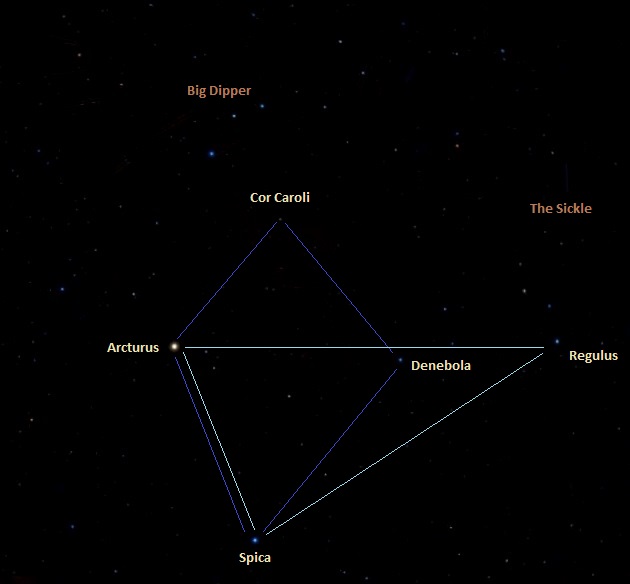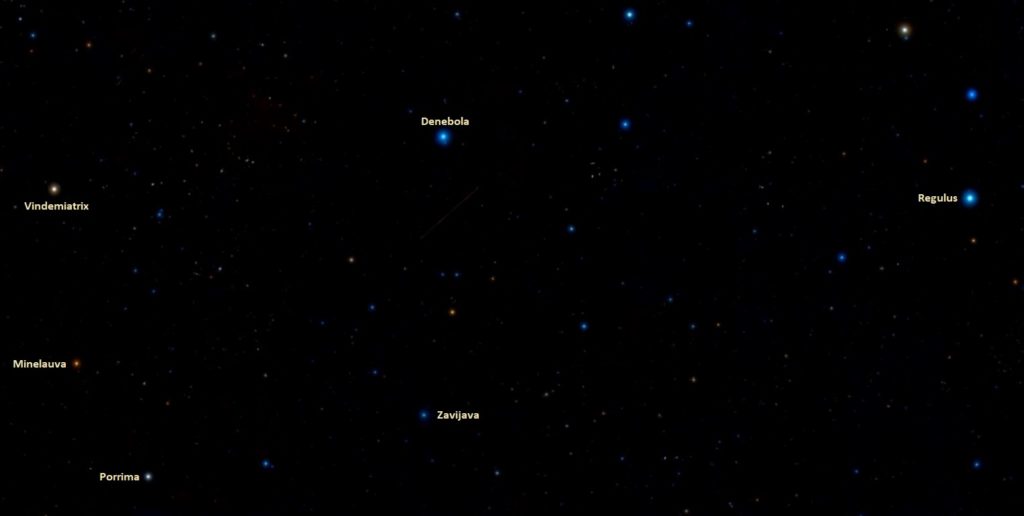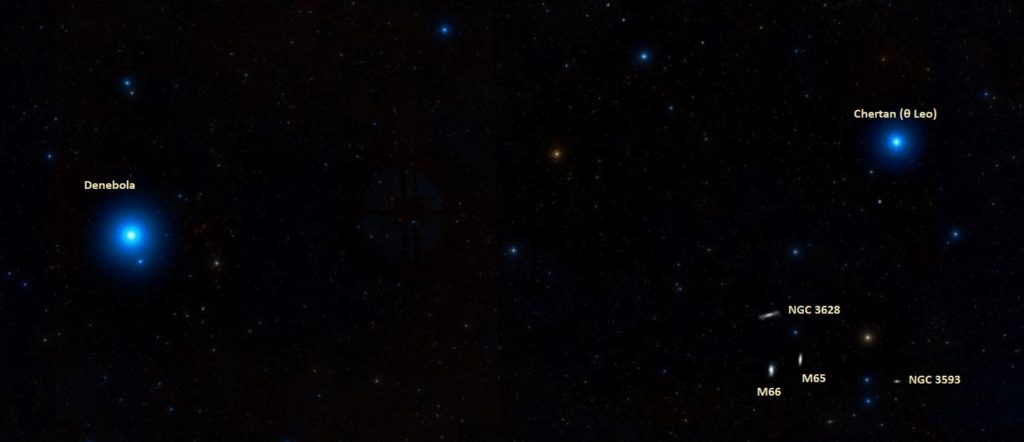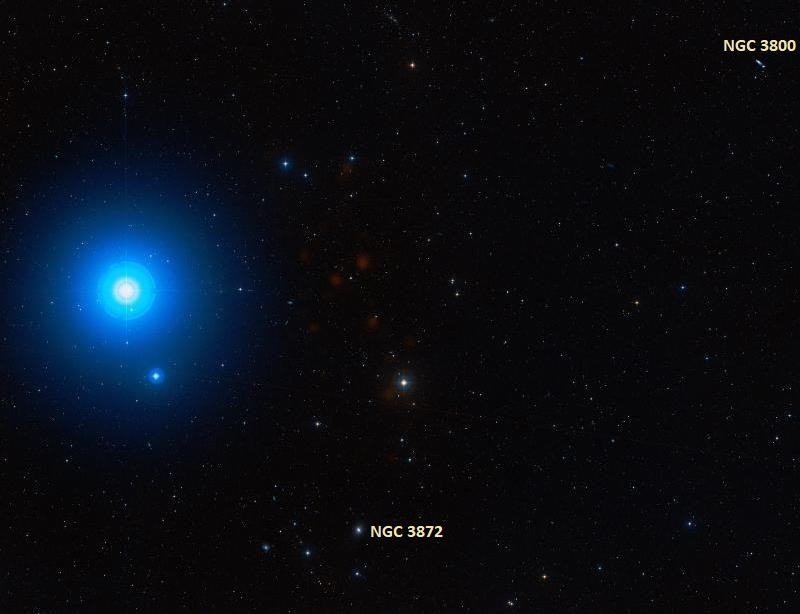Denebola, Beta Leonis (β Leo), is a white main sequence star located in the constellation Leo. With an apparent magnitude of 2.113, it is the third (individually the second) brightest star in Leo, after Regulus and Algieba. Denebola lies at a distance of 35.9 light years from Earth. It marks the tail of the celestial Lion.
Star type
Denebola has the stellar classification A3Va, indicating a hydrogen-fusing dwarf appearing white in colour. The luminosity class “Va” indicates that it is highly luminous for a main sequence star. Its estimated age is between 100 and 380 million years.
Denebola has a mass 1.78 times that of the Sun and a radius 1.728 times solar. With a surface temperature of 8,500 K, it is 15 times more luminous than the Sun. The star is a fast spinner, with a projected rotational velocity of 128 km/s. Because of its fast rotation rate, Denebola is flattened at the poles and has an equatorial bulge. Its shape is an oblate spheroid.
Denebola is a suspected variable star of the Delta Scuti type. Delta Scuti variables are young pulsating stars that exhibit slight variations in brightness (less than 1 magnitude) over a period of 30 minutes to 7 hours due to both radial and non-radial pulsations. Denebola shows fluctuations in brightness of 0.025 magnitudes about 10 times per day.
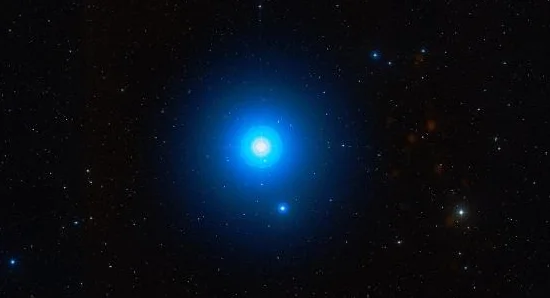
Denebola (Beta Leonis), image: Wikisky
Facts
Denebola and the brighter Regulus are among the 58 stars selected for navigation. They are two of the 16 navigational stars located in the equatorial region of the eastern hemisphere. Navigational stars have a special status in the field of celestial navigation because they are exceptionally bright and easy to identify. Other navigational stars in this area of the sky include the bright Sirius in the constellation Canis Major, Aldebaran in Taurus, Procyon in Canis Minor, Alphard in Hydra, Pollux in Gemini, Alpheratz in Andromeda, Diphda in Cetus, and Betelgeuse and Rigel in Orion.
Denebola marks one of the vertices of the Great Diamond. Also known as the Diamond of Virgo, the asterism is a prominent feature of the spring sky. It is also formed by the bright Arcturus in the constellation Boötes, Spica in Virgo, and Cor Caroli in Canes Venatici.
Along with Arcturus and Spica, Denebola is sometimes also considered to be part of the Spring Triangle instead of Regulus. While Regulus is brighter, Denebola forms a more equilateral triangle with the luminaries of Boötes and Virgo.
The variability of Denebola was first reported in 1970 by M. S. Frolov, who included the star on the list of suspected Delta Scuti variables. In 1981, C. Bartolini et al. reported variations in brightness with an amplitude of 0.025 magnitudes over a period of 0.05 days. A study published in 1998 found evidence of a short period radial velocity variability with a period of 0.108 days.
Denebola shows excess emissions in the infrared. Observations with the Infrared Astronomical Satellite (IRAS) in the 1980s attributed these to circumstellar dust. The star is surrounded by an isothermal dust shell with a temperature of about 120 K (-153° C) and a radius of 39 astronomical units from the star. The radius of the debris disk was resolved in images obtained with the Herschel Space Observatory and released in 2010. Such disks contain populations of colliding planetesimals, which supply the dust, and make the host stars candidate locations for exoplanets. There is still no direct evidence of any planets orbiting Denebola, but their existence has not been ruled out either.
Denebola is a proposed member of the Argus Association (the IC 2391 supercluster), a stellar association that also includes the open cluster IC 2391 (the Omicron Velorum Cluster) and the stars Alpha Pictoris, Gomeisa (Beta Canis Minoris), and Epsilon Pavonis. These stars are not gravitationally bound, but they share a common motion through space, indicating that they formed in the same stellar nursery and were once members of an open cluster.
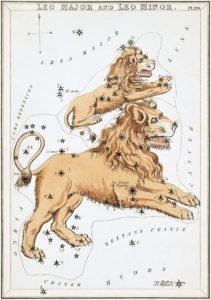
“Leo Major and Leo Minor,” plate 20 in Urania’s Mirror (1824), a set of 32 astronomical star chart cards based on Alexander Jamieson’s A Celestial Atlas, engraved by Sidney Hall
Denebola is one of the several bright stars with names that refer to the tails of the animals that the constellations represent. Other “tail” stars are Deneb (Alpha Cygni), marking the tail of the Swan (Cygnus), Deneb Algedi (Delta Capricorni), the tail of the Goat (Capricornus), and Aldhanab (Gamma Gruis), originally marking the tail of the Southern Fish, but now representing the eye of the Crane (Grus).
Additionally, Diphda (Beta Ceti) was traditionally known as Deneb Kaitos, the tail of the Sea Monster (Cetus), while Iota Ceti was called Deneb Kaitos Shemali, the northern tail of the Sea Monster, and Eta Ceti was Deneb Algenubi, the southern tail of the Sea Monster.
Zavijava (Beta Virginis), a magnitude 3.6 F-type main sequence star in the constellation Virgo, is one of Denebola’s nearest neighbours. The stars are only 8 light years apart. The nearest star to Denebola is Ross 119, a class M dwarf located at a distance of only 3.6 light years from Denebola. In comparison, the distance from the Sun to the nearest star system, Alpha Centauri, is 4.37 light years.
Name
The name Denebola (pronunciation: /dəˈnɛbələ/) comes from the Arabic name Deneb Elased, derived from ðanab al-asad, meaning “the tail of the lion.” It refers to the star’s position in the constellation. Variations include Denebalezeth, Denebaleced, Dhanbol-asadi, Nebolellesed, and Deneb Aleet.
The name Denebola was officially approved by the International Astronomical Union’s (IAU) Working Group on Star Names (WGSN) on June 30, 2016.
The Greeks knew the star as Alkaia, meaning “mallow.” In the Alfonsine Tables, it was listed as Denebalezeth and as Dafira, the latter denoting the tuft of hair at the end of the lion’s tail. In Persian astronomy, Denebola was known as Avdem, meaning “the one in the tail.” The 15th century Timurid astronomer Ulugh Beg called it Al Ṣarfah, meaning “the changer.” The name refers to the change in weather heralded by the star. As the 11th century Iranian scholar Al-Biruni explained, “The heat turns away when it rises, and the cold turns away when it disappears.”
The Chinese name for Denebola is 五帝座一 (Wǔdìzuò-yī), the First Star of the Thrones of the Five Emperors. The Chinese asterism called Thrones of the Five Emperors is formed by Denebola with the stars HIP 57646, HIP 57320, 95 Leonis, and HIP 57779. It is part of the Supreme Palace enclosure.
In Hindu astronomy, the star is associated with a nakshatra (lunar mansion) called Uttara Phalgunī.
Location
Denebola is relatively easy to find because it is part of the Great Diamond and lies near the prominent Sickle of Leo. Both the Great Diamond and the Sickle can be found using the bright stars of the Big Dipper. A line extended from Megrez through Phecda, the inner stars of the Dipper’s bowl, points toward Regulus, the star that sits at the base of the Sickle and marks the heart of the celestial Lion.
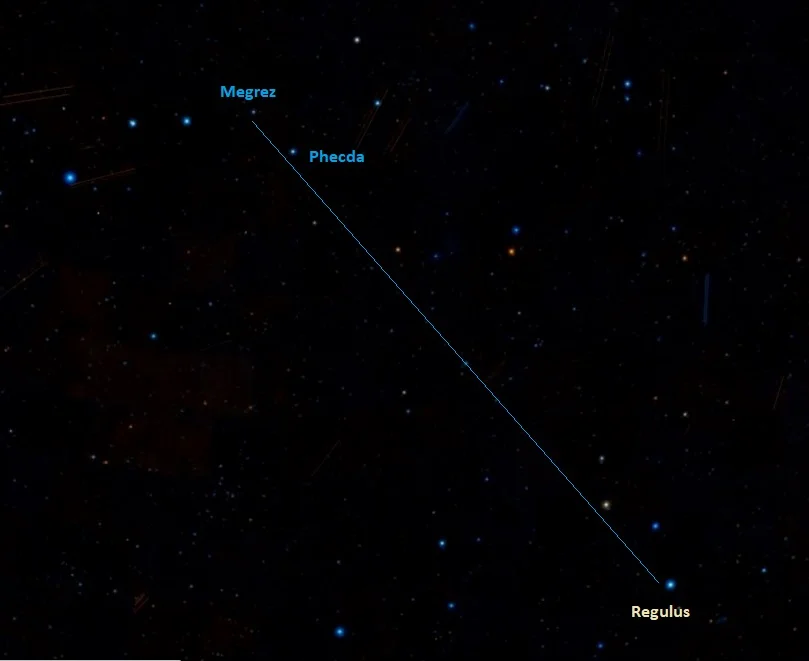
The Big Dipper and the Sickle of Leo, image: Wikisky
Denebola lies on the eastern side of Leo, marking its tail. It forms a triangle with its neighbours Zosma (Delta Leonis) and Chertan (Theta Leonis).
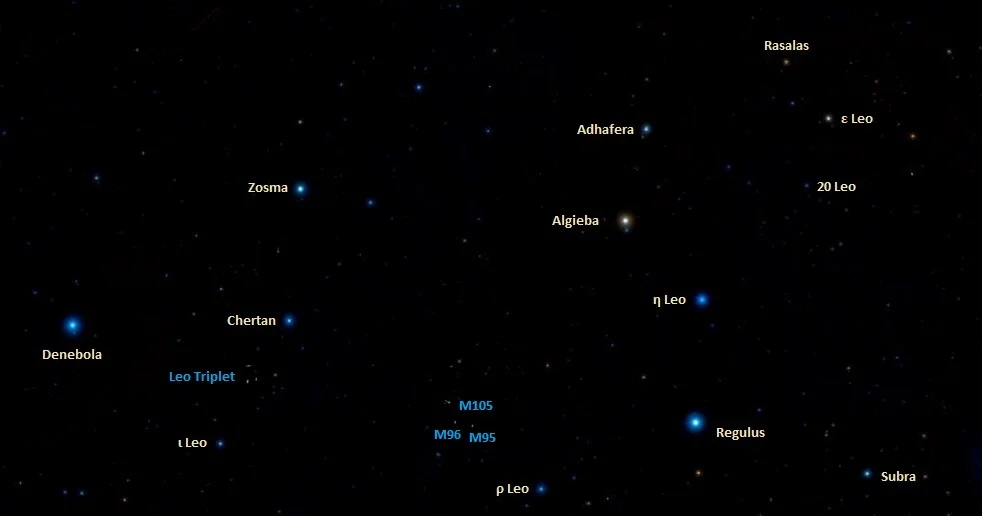
Leo stars, image: Wikisky
The stars of the Great Diamond are just as easy to identify. Cor Caroli lies directly below Alkaid, the leftmost star of the handle of the Big Dipper, marking the tip of the Great Bear’s tail. Arcturus and Spica are found by following the arc of the Dipper’s handle. Arcturus is the first bright star that appears along this curved line and Spica is the second.
Denebola is well-known to stargazers because it is used to find the Virgo Cluster, a cluster of galaxies that contains many bright members catalogued by Charles Messier. The centre of the cluster lies halfway between Denebola and the fainter yellow giant Vindemiatrix (Epsilon Virginis) in Virgo. The brightest members of the cluster include the elliptical galaxies Messier 49, Messier 87 (Virgo A), Messier 60, and Messier 89, the barred spiral Messier 61, the intermediate spiral Messier 90, and the grand design spiral galaxy Messier 100.
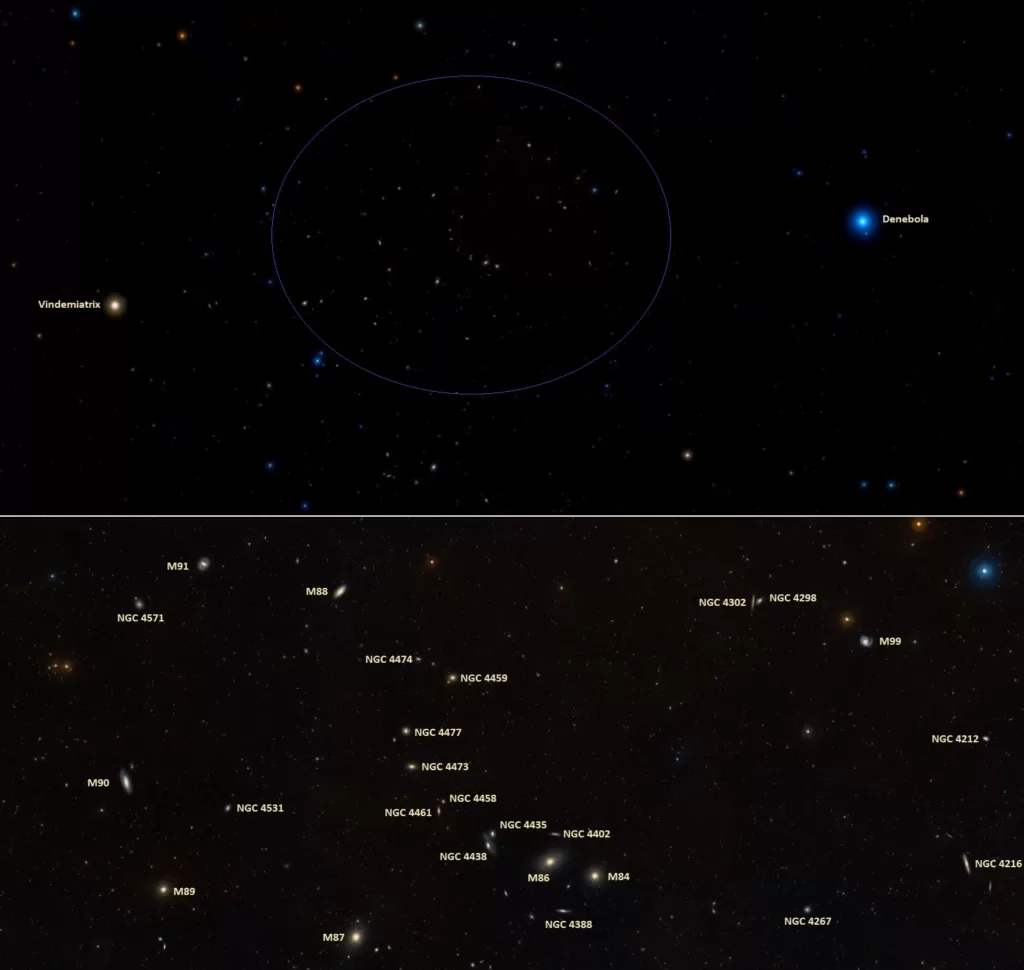
Denebola, Vindemiatrix and the Virgo Cluster, image: Wikisky
Several bright Messier galaxies can also be found in the region of the sky between Denebola and the brighter Regulus. The Leo Triplet of galaxies, consisting of the spiral galaxies Messier 65, Messier 66, and NGC 3628, appears closer to Denebola, while the M96 Group, centred on the spiral galaxy Messier 96 and including the spiral galaxy Messier 95 and the elliptical Messier 105, lies closer to Regulus.
The fainter spiral galaxy NGC 3800 and elliptical NGC 3872 appear in the same field of view as Denebola.
Constellation
Denebola is located in the constellation Leo. Leo is the 12th largest constellation in the sky, occupying an area of 947 square degrees. Like other zodiac constellations, it was first listed by the Greek astronomer Claudius Ptolemy in the 2nd century CE and is considered one of the 48 Greek constellations. Easily recognizable for the Sickle asterism that outlines the Lion’s mane, the constellation represents the Nemean lion that met its end at the hands of Heracles as part of the hero’s Twelve Labours.
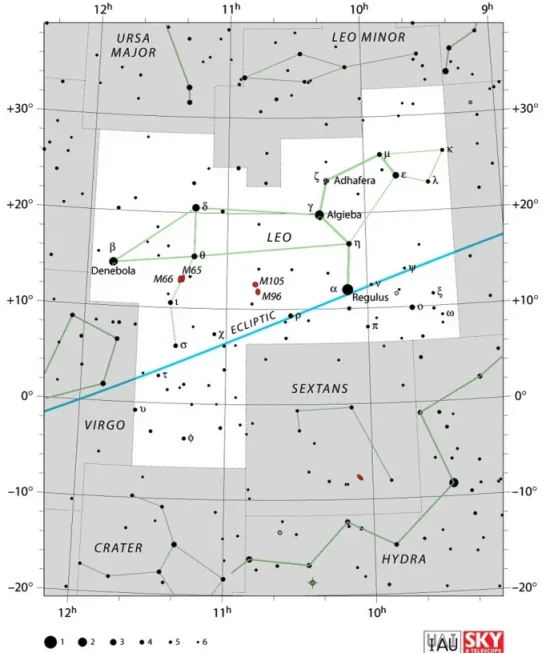
Leo constellation map by IAU and Sky&Telescope magazine
Leo is home to many bright deep sky objects. In addition to the Leo Triplet and the M96 Group, the constellation contains the Frosty Leo Nebula, the spiral galaxies NGC 3785 (the Smiley Face Galaxy or Owl Galaxy), NGC 2903, NGC 3626, NGC 3370 (the Silverado Galaxy), NGC 3190, and NGC 3607, the Leo Cluster of galaxies, whose brightest member is the elliptical galaxy NGC 3842, and the interacting galaxies NGC 3226 and NGC 3227 (Arp 94).
Leo also contains Wolf 359, one of the nearest stars to the Sun, the red dwarf K2-18, Icarus (MACS J1149 LS1), one of the most distant stars known, the carbon star CW Leonis, the brightest star in the infrared N-band (10 μm), the variable red giant R Leonis, and Caffau’s Star (SDSS J102915+172927), one of the oldest known stars in our galaxy with an estimated age of 13 billion years.
The best time of year to observe the stars and deep sky objects in Leo is during the month of April, when the constellation rises high in the evening sky.
The 10 brightest stars in Leo are Regulus (Alpha Leo, mag. 1.40), Algieba (Gamma Leo, mag. 2.08), Denebola (Beta Leo, mag. 2.113), Zosma (Delta Leo, mag. 2.56), Epsilon Leonis (mag. 2.98), Chertan (Theta Leo, mag. 3.324), Adhafera (Zeta Leo, mag. 3.33), Eta Leonis (mag. 3.486), Subra (Omicron Leo, mag. 3.52), and Shaomin (Rho Leo,mag. 3.9).
Denebola – Beta Leonis
| Spectral class | A3Va |
| Variable type | Delta Scuti (suspected) |
| U-B colour index | +0.153 |
| B-V colour index | +0.107 |
| Apparent magnitude | 2.113 |
| Absolute magnitude | +1.93 |
| Distance | 35.9 ± 0.2 light years (11.00 ± 0.06 parsecs) |
| Parallax | 90.91 ± 0.52 mas |
| Radial velocity | -0.2 km/s |
| Proper motion | RA: –497.68 mas/yr |
| Dec.: –114.67 mas/yr | |
| Mass | 1.78 M☉ |
| Luminosity | 15 L☉ |
| Radius | 1.728 R☉ |
| Temperature | 8,500 K |
| Metallicity | +0.00 dex |
| Age | 100 – 380 million years |
| Rotational velocity | 128 kms |
| Surface gravity | 4.0 cgs |
| Constellation | Leo |
| Right ascension | 11h 49m 03.57834s |
| Declination | +14° 34′ 19.4090″ |
| Names and designations | Denebola, Deneb Elased, Deneb Aleet, Beta Leonis, β Leo, 94 Leonis, HD 102647, HR 4534, HIP 57632, SAO 99809, GC 16189, GCRV 7151, LHS 2462, FK5 444, PPM 128576, LTT 13249, BD+15°2383, GJ 448, GCTP 2738.00, ADS 8314 A, CCDM J11490+1433A, CSV 101225, IDS 11440+1508 A, IRAS 11464+1451, 2MASS J11490366+1434197, PLX 2738, TYC 870-988-1, WDS J11491+1434A |
